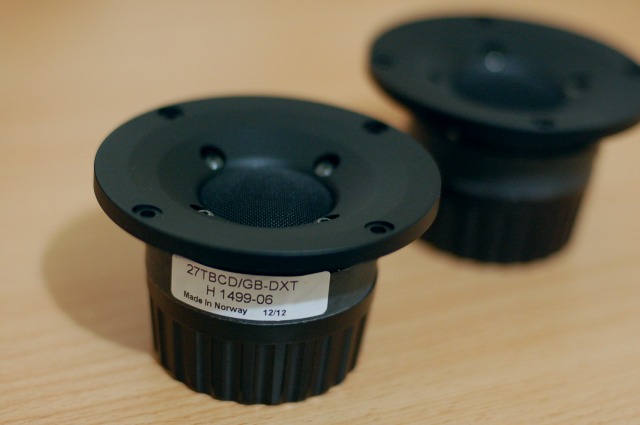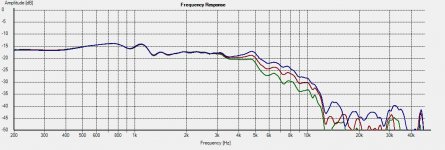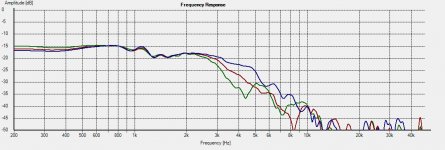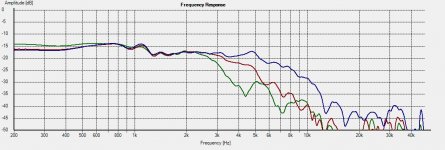+ for 5htElement and MarkK's original ER18DXT. I've listened to them for more than 2 years now. The webpage is here The Seas ER18DXT ported two way
I too have this capability although not via the DEQX, it can be quite interesting. I assume that you use the DEQX to dial in perfect (ie non asymmetric) acoustic slopes and then phase align each of the designs using time delay before auditioning the different designs.
The DEQX does the following:
- Linear-Phase crossovers implemented via long FIR (Finite Impulse Response) filters.
- Frequency response correction to within 0.5dB, often better.
- Phase and time response correction
- Group delay correction
- Precise time alignment with zero phase error
- Linear-phase zero-distortion digital crossovers
- High-order crossovers to 300dB/octave eliminate driver interaction. I usually use 48dB/octave for well-behaved drivers.
Basically after the filter and correction is applied you have virtually a straight line for the frequency response and everything is time aligned etc. and that goes for all different cross-over points you choose to upload to the DEQX.
Still, when you swap between the different cross-over filters 1.5, 2, 2.5 and 3kHz they sound a bit different, definitely not night and day changes, but subtle changes that are clearly audible. In these setups I often think the mid-woofer does a better job of playing mid-range than the tweeter even if the frequency response is the same and distortion etc. isn’t an issue.
5th element,
I think you did a very good job of summing it up in post #20

I’ve attached some pictures to show how the off-axis response looks like for the SEAS U16RCY/P (without cross-over).
All measurements are made at tweeter height @ 1m (13.5cm above mid-woofer center). The frequency plots a normalized and 1/24 octave smoothing is applied.
Picture1:
Blue = 0deg
Red = 15deg
Green = 22.5deg
Picture2:
Blue = 30deg
Red = 45deg
Green = 60deg
Picture3:
Blue = 0deg
Red = 30deg
Green = 60deg
At 2.8kHz @ 30deg the mid-woofer starts to roll-off, respectively 2.6kHz @ 45deg and 2.3kHz @ 60deg.
Regards
/Göran
Attachments
Last edited:
Always interesting to follow your builds Göran, looking forward to the restWhat size cabinet are you using for this one?
/U.
Thank you!
I'm using the PartsExpress 14liter Dayton Audio TWC-0.50BK 0.50 ft 2-Way Curved Cabinet enclosure for this build.
It has a baffle size of 35,56x21,56cm
Regards
/Göran
Prestigious Two – Monitor DXT Released!
I’ve finished the fine-tuning of the loudspeaker and I've published the complete design write-up.
Prestigious Two – Monitor DXT Loudspeaker Design
SEAS H1520 U16RCY/P Measurements
SEAS H1499 27TBCD/GB-DXT Measurements
I think it turned out to be a very nice modestly priced loudspeaker design. The SEAS DXT tweeter, although not my absolute favorite tweeter is a very interesting concept with great potential and I hope to see more of its kind from SEAS and other loudspeaker driver unit manufacturers.
I’ve tested and used the DXT tweeter in several designs and I think it really shines when used as in this setup, with a LR2 (acoustical) filter topology.
The bass from the small SEAS U16RCY/P is very good and I think the warm mid-range character it reproduces, will appeal to many people.
I also think the cross-over design worked out the way I wanted, with a minimalistic design approach and with very few components. It’s not often a loudspeaker design work out as good as this with a first-order (electrically) filter topology, but both these good drivers can handle it.
This is the last design I publish before the family vacation starts, but stay tuned I have several exciting designs coming soon.
First of all I’m starting the “Sequence Three – Grand Reference” build this summer and parallel to it I will start the work with the “Revelation Two – Monitor MkII”, which will be released with two new different tweeter flavors.
Sequence Three – Grand Reference Construction!
I wish you all a very nice warm and sunny summer!
Regards
/Göran
I’ve finished the fine-tuning of the loudspeaker and I've published the complete design write-up.

Prestigious Two – Monitor DXT Loudspeaker Design
SEAS H1520 U16RCY/P Measurements
SEAS H1499 27TBCD/GB-DXT Measurements
I think it turned out to be a very nice modestly priced loudspeaker design. The SEAS DXT tweeter, although not my absolute favorite tweeter is a very interesting concept with great potential and I hope to see more of its kind from SEAS and other loudspeaker driver unit manufacturers.
I’ve tested and used the DXT tweeter in several designs and I think it really shines when used as in this setup, with a LR2 (acoustical) filter topology.
The bass from the small SEAS U16RCY/P is very good and I think the warm mid-range character it reproduces, will appeal to many people.
I also think the cross-over design worked out the way I wanted, with a minimalistic design approach and with very few components. It’s not often a loudspeaker design work out as good as this with a first-order (electrically) filter topology, but both these good drivers can handle it.
This is the last design I publish before the family vacation starts, but stay tuned I have several exciting designs coming soon.
First of all I’m starting the “Sequence Three – Grand Reference” build this summer and parallel to it I will start the work with the “Revelation Two – Monitor MkII”, which will be released with two new different tweeter flavors.
Sequence Three – Grand Reference Construction!
I wish you all a very nice warm and sunny summer!
Regards
/Göran
Prestigious Two – Monitor DXT Tweeter Level Option Update!
Hi everyone,
After a period of additional listening tests and by the request of DIY builders, I’ve released some additional tweeter level tuning options for the Prestigious Two – Monitor DXT loudspeaker design.
More information can be found here:
Additional tweeter level options!
Prestigious Two – Monitor DXT
Summer greetings!
/Göran
Hi everyone,
After a period of additional listening tests and by the request of DIY builders, I’ve released some additional tweeter level tuning options for the Prestigious Two – Monitor DXT loudspeaker design.
More information can be found here:
Additional tweeter level options!
Prestigious Two – Monitor DXT
Summer greetings!

/Göran
Hi Göran, very nice and well documented loudspeaker design !
I'm waiting delivery for a pair of Seas DXT but can you spoil it and tell us what you think about these tweeters ??... are they clean and smooth sounding.... no 'diffraction' sound ??
Thank you gainphile!
The SEAS DXT tweeter is a good driver that measures well and the diffraction effect isn’t so pronounced thanks to the DXT lens. I hope that SEAS and others will follow this concept and offer more choices in both driver options and waveguide sizes.
I think it’s very hard to describe how something sounds especially a tweeter alone, but to me its character is neutral and not entirely different than other metal domes from SEAS. That could be a good or bad thing depending on personal taste and preferences.
The DXT is also a bit tricky to work with and I think it sounds the best with simple low-order filters like I did in my latest build. It also have a huge cone break-up at 27kHz which results in an elevated odd-order distortion that propagates down to the upper treble and that most likely adds to the sonic character.
Is it the best tweeter money can buy? No, sorry it’s not.
Regards
/Göran
Gainphile, as you've used the WG300 from monacor you are therefore know what wave-guides sound like. It's a bit of a vague comment, but the DXT offers some of what the WG300 can do, just not as much of it.
With regards to the large peak @ 27kHz finding its way into the harmonic distortion via resonance amplification, this is an issue in mid/bass drive units, but I think it's much less of an issue in tweeters as the harmonics produced are higher then what we can hear. The only way these could be audible is via the creation of IMD products.
In my experience the DXT sounds very smooth and detailed with less 'spit' then other standard domes, mainly due to the wave-guide. It is also sounds noticeably better then standard domes when listening off axis too, again due to the wave-guide.
With regards to the large peak @ 27kHz finding its way into the harmonic distortion via resonance amplification, this is an issue in mid/bass drive units, but I think it's much less of an issue in tweeters as the harmonics produced are higher then what we can hear. The only way these could be audible is via the creation of IMD products.
In my experience the DXT sounds very smooth and detailed with less 'spit' then other standard domes, mainly due to the wave-guide. It is also sounds noticeably better then standard domes when listening off axis too, again due to the wave-guide.
Thanks... I know it's hard to describe subjectively the sound of drivers 
Yes, have quite experience with various waveguides (big ones to small wg300 ones), compression drivers etc. What I find is they are never as smooth as direct radiators. Although all the measurements are good. Perhaps these are early reflections within the WG which give their character.
I am a metal-cone kind of guy and aware of their 'issues'. In my ears the distortion numbers in higher frequency is no problem. But I dislike phase plug, hence where the DXT fits in! My "best" tweeter so far is Vifa DQ25 with phase shield removed. Sounds great except that resulting massive null at 15khz.
So as I really hope the Seas DXT will be a very nice compromise between smoothness and directivity . I'll report ...
. I'll report ...
Göran, come on.. spill the beans. What are these tweeters you prefer over the DXT
Yes, have quite experience with various waveguides (big ones to small wg300 ones), compression drivers etc. What I find is they are never as smooth as direct radiators. Although all the measurements are good. Perhaps these are early reflections within the WG which give their character.
I am a metal-cone kind of guy and aware of their 'issues'. In my ears the distortion numbers in higher frequency is no problem. But I dislike phase plug, hence where the DXT fits in! My "best" tweeter so far is Vifa DQ25 with phase shield removed. Sounds great except that resulting massive null at 15khz.
So as I really hope the Seas DXT will be a very nice compromise between smoothness and directivity
Göran, come on.. spill the beans. What are these tweeters you prefer over the DXT
With regards to the large peak @ 27kHz finding its way into the harmonic distortion via resonance amplification, this is an issue in mid/bass drive units, but I think it's much less of an issue in tweeters as the harmonics produced are higher then what we can hear. The only way these could be audible is via the creation of IMD products.
I agree with you that this kind of cone break-up for a mid-woofer would be a major issue that would have to be dealt with. The DXT tweeter has one of the sharpest cone break-ups I’ve ever measured and it contributes to a rise of about 8 times in the distortion profile for the third-order harmonics at 9kHz. Unfortunately with my measurement setup I cannot catch this, but I’ve seen other measurements done for this tweeter that shows the effect. One such is the German DIY magazine “Hobby & Hifi” issue 2010/1.
I also think that this effect shouldn’t be exaggerated, but some people are sensitive to it, others aren’t. I think it’s up to each and everyone to listen and see if it’s an issue or not and do their own conclusion. This was my main point with pointing it out. The DXT tweeter is a great driver, but it might not fit everyone’s sonic preferences.
I am a metal-cone kind of guy and aware of their 'issues'. In my ears the distortion numbers in higher frequency is no problem. But I dislike phase plug, hence where the DXT fits in! My "best" tweeter so far is Vifa DQ25 with phase shield removed. Sounds great except that resulting massive null at 15khz.
So as I really hope the Seas DXT will be a very nice compromise between smoothness and directivity. I'll report ...
The DXT tweeter is a great driver and I think you will be happy with it.
Göran, come on.. spill the beans. What are these tweeters you prefer over the DXT
I’ve used so many tweeters over the years, but if you force me to answer and I compare it with some tweeters I’ve recently used.
1. For twice the money ScanSpeak D3004/660000 (a class of its own)
2. For the same amount of money ScanSpeak D2608/913000 “HDS”
3. For less money Dayton Audio RS28F-4 (a good contender to the DXT)
As you can see, none of these are “metal” tweeters.
Yes, I’ve also used the ScanSpeak Beryllium lately, but it’s so expensive so it’s not fair to compare it and it has a unique sonic character that is hard to compare with other hard dome tweeters and soft dome tweeters. I think this is a kind of tweeter you either love or hate, so to speak.For a start, the Scanspeak D3004 Beryllium!
Regards
/Göran
. The DXT tweeter has one of the sharpest cone break-ups I’ve ever measured and it contributes to a rise of about 8 times in the distortion profile for the third-order harmonics at 9kHz.
Indeed and if one played a 9kHz tone through the DXT, the tweeter would generate a third harmonic at 27khz and this would then be amplified by the domes bell mode resonance. We cannot hear this though.
The only way this can be audible in any way would be through the generation of difference tones through IMD. It would be interesting to throw some worst case scenario test signals at the DXT just to see how much of an issue this could potentially be.
Well I didn't have to wait long. Gotta love Madisound and USPS 

It was pretty easy to equalise them to flat actively, just a simple notch centered at around 4khz. I had not bothered to fine tune them yet as they are still surface mounted. But my first impression is very clean, neutral sound.
Looks great too!

It was pretty easy to equalise them to flat actively, just a simple notch centered at around 4khz. I had not bothered to fine tune them yet as they are still surface mounted. But my first impression is very clean, neutral sound.
Looks great too!
Big bump on this thread. I have bought myself a pair of these wave guides. They look the business for sure. I have a mixed bag of experience with wave guides. Thinking of the Monacor 300WG I don't think I got the crossover to work properly which resulted in vague stereo focus.
The rise in the presence band raises some concern with WG's.
Isn't the 27B/G DXT best suited for a narrow baffle design? Because the diffraction edges of the wave guide helps to fill out the drop in baffle support a narrow design would result in the end result would be a flat respons easily mated with the mid/bass unit.
I'm going to put my 27mm all dome with the DXT lens on top of a bass/mid enclosure mounted in its own tweeter housing. I have built a prototype.
The rise in the presence band raises some concern with WG's.
Isn't the 27B/G DXT best suited for a narrow baffle design? Because the diffraction edges of the wave guide helps to fill out the drop in baffle support a narrow design would result in the end result would be a flat respons easily mated with the mid/bass unit.
I'm going to put my 27mm all dome with the DXT lens on top of a bass/mid enclosure mounted in its own tweeter housing. I have built a prototype.
- Status
- This old topic is closed. If you want to reopen this topic, contact a moderator using the "Report Post" button.
- Home
- Loudspeakers
- Multi-Way
- Seas U16RCY/P + Seas 27TBCD/GB-DXT = Prestigious Two – Monitor DXT


